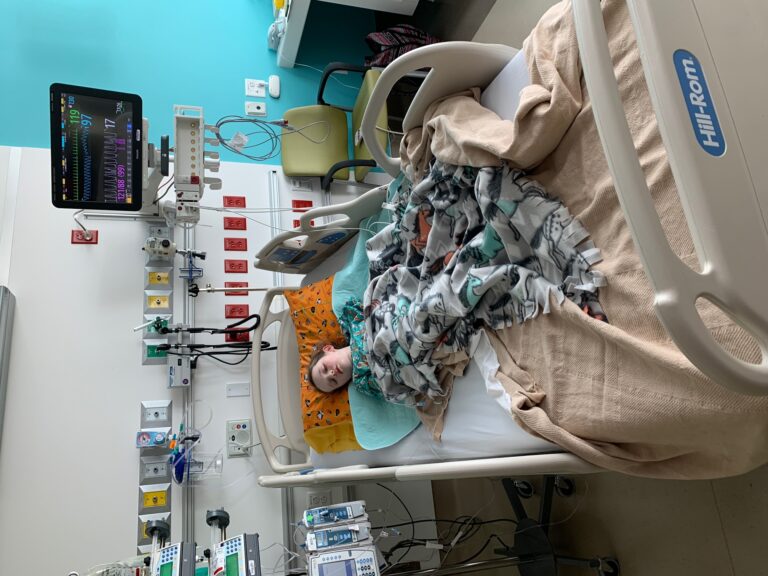Disney World is supposed to be the happiest place on earth, but for Pam Anderson it was the worst.
“No one saw it coming. You spend thousands of dollars to go to Disney World and you end up seeing just the inside of a very nice hospital.”

Pam is the Accounts Payable/ Gift Processing Coordinator at Children’s Hospital Foundation of Manitoba, but never imagined her family would need support at HSC Children’s the way they do now.
In February 2019 at the start of their trip to Florida, Pam’s youngest daughter, Aundreya (who was 7 at the time), got very sick. At first she was irritable and extremely thirsty, then she began vomiting so Pam and her husband Kevin took Aundreya to the local emergency room.
Doctors ran a number of tests and discovered Aundreya had type 1 diabetes and was in diabetic ketoacidosis, a serious condition where your cells aren’t getting the glucose they need for energy so your body begins to burn fat, which produces ketones and can bring on a diabetic coma.
Aundreya was admitted to the PICU at a children’s hospital close by and put in isolation because she also tested positive for human metapneumovirus (HMPV), which can cause respiratory disease.
“There were a couple days we just had to watch her lay in the bed, no function, not really even waking up, and if she did it was only for a couple of minutes and then she’d fall asleep again,” says Pam.
Doctors explained that the HMPV brought Aundreya’s diabetes out of a dormant state. As Aundreya began to regain her strength, Pam and Kevin had to learn how to manage her condition.
“It’s extremely overwhelming at first, it’s shocking, and not just for you and for that child – it was a family change. It was something that affected us all and it still does,” says Pam.
Returning to Canada brought even more challenges, as Pam and Kevin had to learn how to dole out insulin in metric measurements, completely shift their family’s meals, and manage the changes at home with Aundreya, her sister Kaiebrie, and step-sister Taylor.
“You want to go for ice cream or you want to get a Slurpee, it has to be preplanned. You can’t just roll up and have a Slurpee or your kid’s going to end up in the hospital.”
Within days of being home Pam and Aundreya had an appointment at the Diabetes Education Resource for Children & Adolescents (DER-CA). This expert team helps families cope with diabetes and offers ongoing support. The staff includes a pediatric endocrinologist, clinical nurse specialist, nurse educator, dietitian educator, social worker, psychologist, transition coordinator and a physician on call 24 hours.
Aundreya continues to see specialists at DER-CA once every three months, and Pam calls whenever she has questions.
“We’re in good hands and they’re always there. It doesn’t matter if it’s my scheduled appointment or if it’s out of the blue, I can email or phone my educator at any time,” says Pam. “It’s been a whirlwind, but they’re still giving us everything we need.”
Pam is grateful to HSC Children’s Hospital, and says her experience with Aundreya’s condition has given her a new perspective on her role at the Foundation.
“It’s the cause for me. If it’s not your kid, it could be your kid’s kid one day. If it’s not your neighbour, it’s your sister’s neighbour. Or maybe it’s your own kid’s classmate. They’re our future. When your kid suffers or when you personally know a kid that’s suffering it’s that feeling you don’t want anyone else to feel.”
Signs of Type 1 Diabetes
Source: Mayo Clinic
Type 1 diabetes happens when the pancreas produces little or no insulin. Insulin allows sugar to enter cells to produce energy.
It can be difficult to spot Type 1 diabetes. Signs and symptoms can appear relatively suddenly and may include:
- Increased thirst
- Frequent urination
- Bed-wetting in children who previously didn’t wet the bed during the night
- Extreme hunger
- Unintended weight loss
- Irritability and other mood changes
- Fatigue and weakness
- Blurred vision
Consult your doctor if you notice any of the above signs and symptoms in you or your child.
Stay in touch!
Sign up for e-news to get updates on the latest events, news, and stories.
sign up for the newsletter